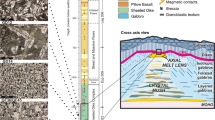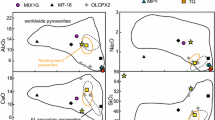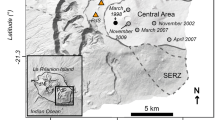Abstract
Flood basalt provinces may constitute some of the most catastrophic volcanic events in the Earth's history. A popular model to explain them involves adiabatic ascent of plumes of anomalously hot peridotite from a thermal boundary layer deep in the mantle, across the peridotite solidus. However, peridotitic plumes probably require unreasonably high potential temperatures to generate sufficient volumes of magma and high enough melting rates to produce flood volcanism. This lead to the suggestion that low melting eclogitic or pyroxenitic heterogeneities may be present in the source regions of the flood basalts. In order to constrain petrogenetic models for flood basalts generated in this way, an experimental investigation of the melting relations of homogeneous peridotite + oceanic basalt mixtures has been performed. Experiments were conducted at 3.5 GPa on a fertile peridotite (MPY90)–oceanic basalt (GA1) compositional join. The hybrid basalt + peridotite compositions crystallised garnet lherzolite at subsolidus temperatures plus quenched ne-normative picritic liquids at temperatures just above the solidus, over the compositional range MPY90 to GA150MPY9050. The solidus temperature decreased slightly from ∼1500 °C for MPY90 to ∼1450 °C for GA150MPY9050. Compositions similar to GA130MPY9070 have 100% melting compressed into a melting interval which is approximately 50–60% smaller than that for pure MPY90, due to a liquidus minimum. During adiabatic ascent of hybrid source material containing a few tens of percent basalt in peridotite, the lower solidus and compressed solidus–liquidus temperature interval may conspire to substantially enhance melt productivity. Mixtures of recycled oceanic crust and peridotite in mantle plumes may therefore provide a viable source for some flood volcanics. Evidence for this would include higher than normal Fe/Mg values in natural primary liquids, consistent with equilibration with more Fe-rich olivine than normal pyrolitic olivine (i.e. <Fo89–92). Modelling of fractionation trends in West Greenland picrites is presented to demonstrate that melts parental to the Greenland picrites were in equilibrium at mantle P–T conditions with olivine with Fo84–86, suggesting an Fe-enriched source compared with normal peridotite, and consistent with the presence of a basaltic component in the source.
Similar content being viewed by others
Author information
Authors and Affiliations
Additional information
Received: 29 October 1999 / Accepted: 3 February 2000
Rights and permissions
About this article
Cite this article
Yaxley, G. Experimental study of the phase and melting relations of homogeneous basalt + peridotite mixtures and implications for the petrogenesis of flood basalts. Contrib Mineral Petrol 139, 326–338 (2000). https://doi.org/10.1007/s004100000134
Published:
Issue Date:
DOI: https://doi.org/10.1007/s004100000134




